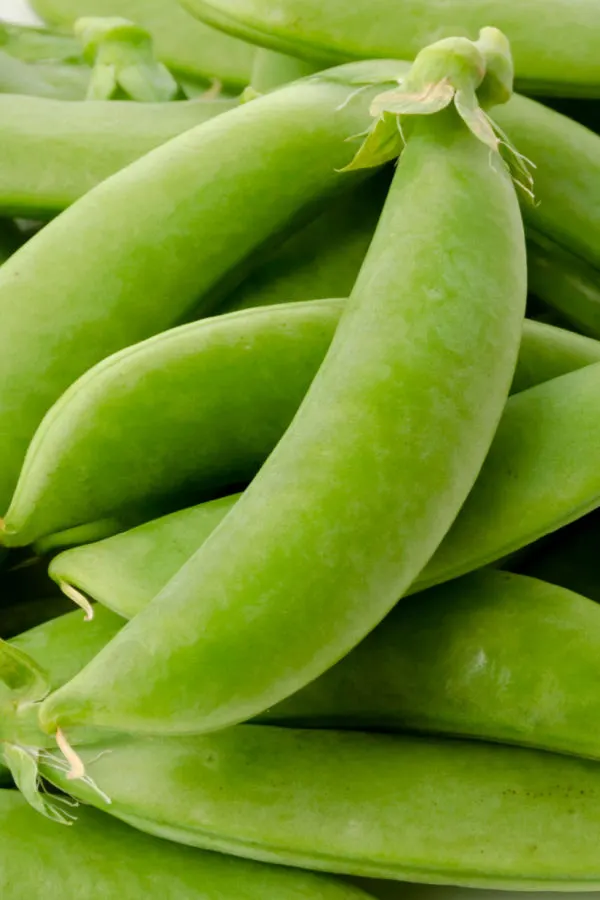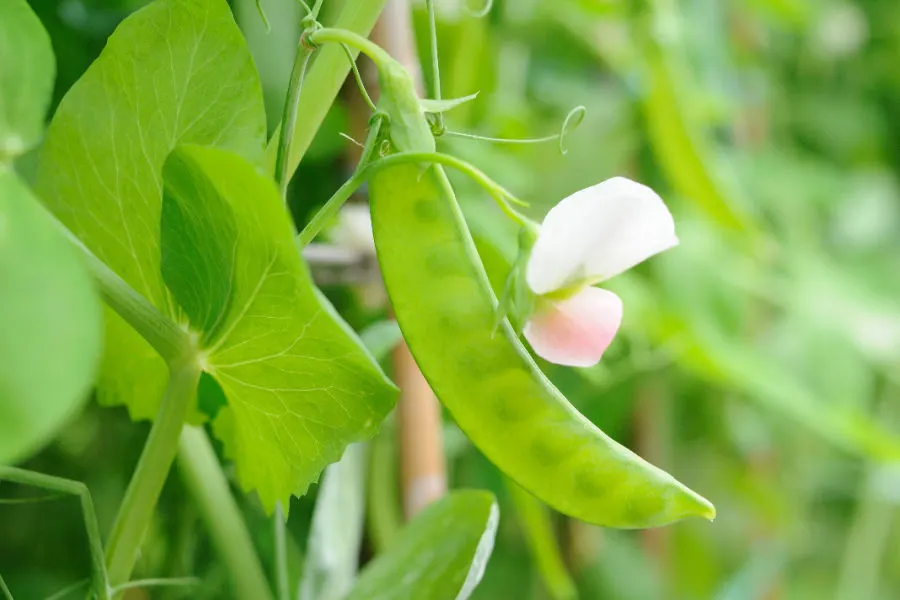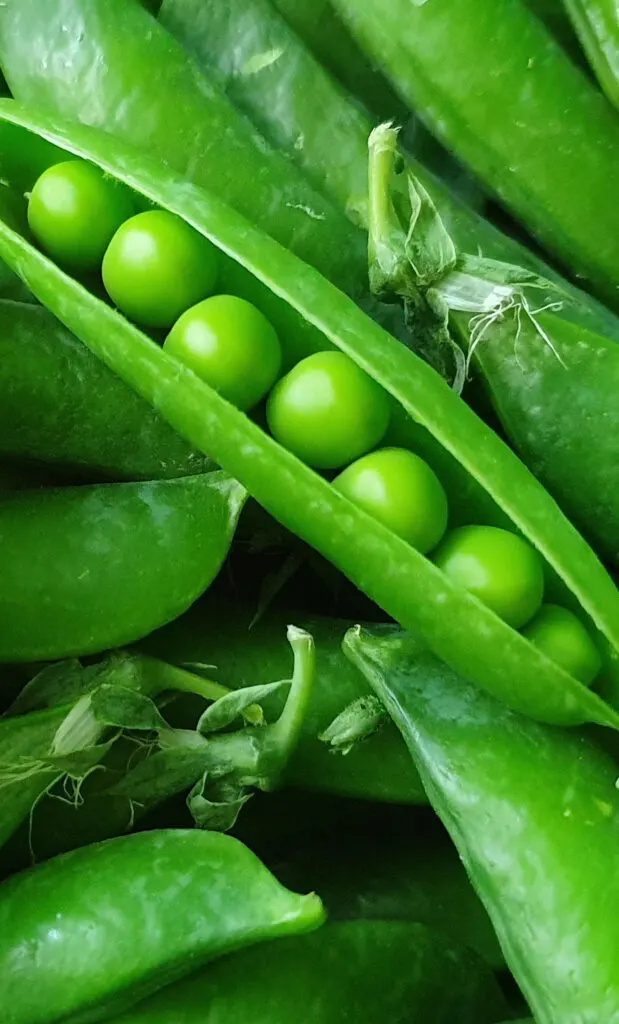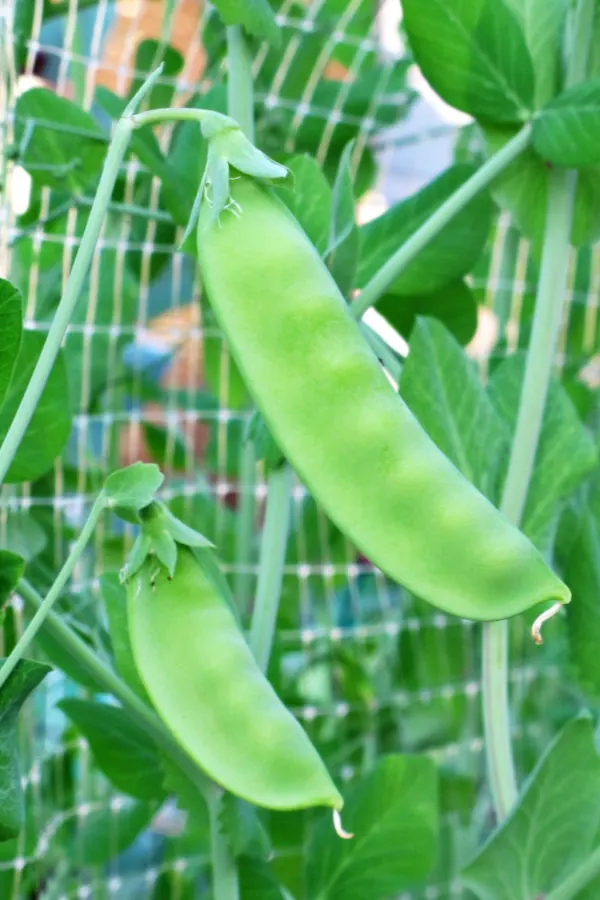Planting and growing your own delicious crop of sugar snap peas couldn’t be easier – and even better, because it thrives in cooler weather, you can plant it early in the spring to get your garden season off to a great start!
Sugar snap peas are one of the most favorite “snacking” vegetables of all. With their plump, crunchy outer skin and sweet crunchy peas inside, they ooze with flavor. Especially when they can be plucked from the plant right at the height of their crispness.
For many home gardeners, sugar snap peas are such the fresh treat, they actually have a hard time getting their harvest to make it out of the garden. It’s almost impossible to pass by a plant and resist the temptation of picking and snacking on them right where they grow!

For that very reason and more, when growing in your home garden, getting a big harvest of tasty pods is important. After all, as good as sugar snap peas are fresh, they are also amazingly delicious when grilled, added to stir fries, or mixed into salads.
Even better, when you consider the low-calorie vegetable is a healthy source of fiber, protein and vitamins, growing a bumper crop can provide a healthy food source for everyone in the family.
The good news is that growing a big crop of sugar snap peas is easier than you might imagine. Not only does the plant require little nutrients from the soil, they actually improve it as they grow. And with their quick seed to harvest time, you can actually plant more than one crop per season.
How To Plant Sugar Snap Peas
There are actually three main styles of peas. Probably the most well known of the three is the traditional green shelling pea. Often referred to as English peas, this variety requires shelling of a tough outer skin to reveal the tasty green peas inside.
The remaining two types of peas are snow pea and sugar snap pea – both of which are sweet. The snow pea is a flatter pea and is also wonderful for fresh eating, stir-fries and more.

Although today’s article is about sugar snap peas, it’s important to note that both grow in much the same way and with the same needs. So if you happen to like snow peas as well – you can use the growing info below to produce a big harvest of both this year!
Planting – How To Plant Sugar Snap Peas For A Big Harvest!
When To Plant
When it comes to growing sugar snap peas, there is one requirement more important than any other when it comes to success – and that is you need cool weather. Plain and simple, peas love cool weather. In fact, they thrive in it.
Because of that, peas should be planted in the early spring and early fall. Peas can germinate in cool soil and air temperatures. How cool? As soon as the ground in 40 to 45° and the soil can be worked, they can be planted.
Young pea plants can even handle a bit of frost. In general, they can go in the ground about 2 to 3 weeks before your area’s last frost date. In the spring, this allows them to grow quickly and mature before the hot summer sun arrives.
Unfortunately, once temperatures begin to consistently approach the mid-80’s, peas will begin to end their production. As the heat settles in, pea plants will begin to bolt and fade. But no worries, you can plant again for a fall harvest too!

As the summer wears on, you can once again plant peas as fall approaches. Even though the soil is warm in late summer, the plants still sprout well. And by the time the plants mature and begin to flower, the cool temperatures of fall will once again allow them to produce a big harvest. A harvest that can last right up to the first hard frost or freeze!
How To Plant Peas
Peas do not require super-rich soil to grow well. In fact, as a legume, they actually help to improve the soil they grow in by helping to fix nitrogen levels for the next crop.
There are a long list of great sugar snap varieties to grow, we have listed a few of our favorites below along with our affiliate seed links as well. Wherever you get your seeds, be sure to order or pick them up early as spring crops usually are the first to sell out.
Sugar Snap Pea Seed Links:
Pea Seeds – Sugar Ann Variety (Snap Peas)
Pea Seeds (Organic) – Sugar Daddy
Since sugar snap peas are an early spring crop that improves soil conditions, growing them where you will be planting tomatoes, peppers or other nitrogen loving vegetables in early summer is a great idea. In fact, many gardeners love to use peas as a green manure crop before summer vegetables go in. See: How To Plant A Green Manure Crop
Sugar snap peas can grow quite easily in a traditional garden, a raised bed, or even a container. Wherever you grow them, it is best to have some type of support or trellis in place to help them sprawl and climb to their full potential.

To plant, create a small furrow or planting hole three-quarters to one inch deep in the soil. As you plant, space the seeds approximately one inch apart. If planting in rows, keep your pea rows at eighteen to twenty-four inches apart. This will allow enough room to harvest between rows.
Supporting Your Crop – How To Plant Sugar Snap Peas For A Big Harvest!
As mentioned above, sugar snap peas do not require a support or trellis to grow and produce. However, they are much easier to manage if allowed to climb. It will also help the plants produce a bigger crop. Allowing them to simply sprawl on the ground reduces their growth and can keep flower production down.
So what is the best way to support? In a garden or raised bed setting, a simple piece of fencing on a couple of stakes in the middle of each planting row will do the trick. You can also plant and grow them along fence lines for a “built-in” trellis.
For container plantings, a simple wood or metal trellis behind your peas works well. You can also plant your peas in a container next to an arbor, trellis or fence. They will find their way up and along any structure that they can swirl their tendrils around.
One thing is for sure, not only will supporting them help grow a bigger harvest, it really makes harvesting a breeze!
Maintaining Your Crop – How To Grow Sugar Snap Peas For A Big Harvest!
Once planted, a few basic gardening chores can get your sugar snap pea crop off to a good start. The first of which is watering the seeds in after planting. Peas do not require a ton of water, but if your soil is dry at planting time, watering will speed germination.

Beyond that, only water your crop if the soil becomes overly dry. When watering pea vines, try to water at the ground level to avoid issues with mildew or mold. Again, most pea crops once sprouted will not need to be watered – only in extremely dry conditions.
Another chore that is highly beneficial to sugar snap peas is to mulch the soil underneath where they grow. Mulch helps eliminate weeds. It also helps conserve moisture as well. In addition, mulch helps to regulate the soil temperature and keep it much cooler if early hot weather arrives.
After planting, cover the soil with a light coating of straw or shredded leaves. At this point, place about an inch of mulch down to allow the seeds to germinate more easily. Once the peas shoot up, layer on a few more inches for a total of three to four inches of mulch.
Harvesting – How To Plant Sugar Snap Peas For A Big Harvest!
You will want to harvest your sugar snap peas as often as you can. Once the pods become plump and full, pluck them from the vines for maximum freshness. Peas picked too early will be flatter and tasteless. But if you leave them on too long, they will become woody and tough.
Pea plants will continue to produce blooms as long as the plant is not overloaded. If it becomes too heavy with peas, it is a signal to the plant to stop producing new blooms. So picking regularly not only helps freshness, but your yields as well.

When warm weather finally puts an end to new blooms, simply pull up the plants and compost. Pea plants are one of the best plants to add to your compost pile – and just another way they give back.
If you want to save seeds from your pea plants, allow a few of the plants to remain and dry out. Once the plants and remaining seed pods have turned brown, simply pluck the pods and remove the peas. Store in a cool, dry place and you will be ready to plant your next crop – for free!
Fall Peas
When planting a second crop in late summer / early fall, try to time up your planting so you will have at least 8 to 10 weeks of growing time left before your average first frost. This allows plenty of time for the peas to grow and produce a sizable harvest.
As a general rule of thumb, a fall harvest of peas will not be as prolific as a spring planting. the warmer late weather and impending cold weather usually keep production down a bit – but still at levels that are more than worth the effort of planting.
Here is to planting a crop of sugar snap peas in your garden this year – and to a big harvest as well!
Follow Our Facebook Page For Great Gardening Tips And Advice! This Is My Garden Facebook Page
This Is My Garden is a garden website created by gardeners, for gardeners. Jim and Mary Competti have been writing gardening, DIY and recipe articles and books and speaking for over 15 years from their 46 acre Ohio farm. They publish three articles every week, 52 weeks a year. Sign up today to follow via email, or follow along!
